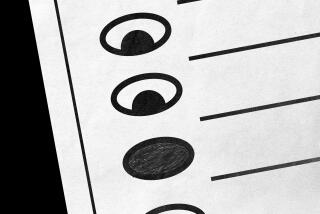Californians to decide on open primary amendment
- Share via
Last spring, two seasoned politicians squared off over a rare open congressional seat. Democrats Judy Chu, then a member of the state Board of Equalization, and state Sen. Gil Cedillo placed first and second, respectively, in a widely watched special primary election in the San Gabriel Valley-area district.
Chu advanced to the July runoff with 32.6% of the vote, but not Cedillo, even though he finished ahead of 10 other candidates by winning 23.2%. The runoff slots went to the top vote-getter from each party with a candidate on the ballot, giving Chu a cakewalk over a Republican and a Libertarian in the strongly Democratic district.
Such special elections are, in effect, open primaries: Voters can choose among all the candidates, regardless of party affiliation. In June, Californians will decide whether to bring back a version of the open primary for regular state and congressional elections.
Supporters of the proposed constitutional amendment cite the Chu-Cedillo battle, among others, in making their case.
“Gil Cedillo was one of the two best candidates in the primary” and should have had a chance to compete in the runoff, said state Sen. Abel Maldonado (R-Santa Maria).
Maldonado won a promise from legislative leaders to put the open-primary measure on the ballot when he crossed party lines in February to vote for tax hikes that helped break a budget impasse. He could benefit from the proposal if it passes, because he has had ambitions to statewide office but may be too moderate to win a Republican primary.
The Top Two Primaries Act would require that all candidates compete in a single primary open to all registered voters -- similar to the way special elections are run. The top two vote-getters would advance to a runoff.
There are some key differences between that proposal and existing rules for special elections. For example, candidates currently must run as party affiliates. Nonetheless, because voters can choose among all candidates, not just the ones from their parties as in regular elections, special elections provide an indication of how the proposed change would work.
Southern California has been awash in special elections this year. In addition to the congressional race, voters were asked to choose a new state senator and a new Assembly member in Los Angeles-area districts and one Assembly member in Orange County.
Both Los Angeles-area districts are heavily Democratic, so candidates from that party would probably continue to hold those seats if the ballot proposal passes. Had it been in place for the state Senate race, for example, then-Assemblyman Curren Price of Inglewood -- the eventual winner -- would have faced Assemblyman Mike Davis of Los Angeles, another Democrat, who came in second in the primary, rather than a Republican or other party member.
Even in districts gerrymandered to favor one party, proponents of the constitutional amendment say, it would give independent voters and those in the non-dominant parties some say in who will represent them. It also would cut down on “meaningless runoffs,” said Allan Hoffenblum, a longtime Republican strategist who publishes the nonpartisan California Target Book, which tracks legislative and congressional races.
Elections are dominated by the two major political parties. That, Hoffenblum said, “more than anything else is why the system is rotten.”
Former Democratic state legislator Steve Peace has led efforts to fashion a new open-primary proposal since the U.S. Supreme Court ruled an earlier voter-approved version unconstitutional. Surveys by the Field Poll and the Public Policy Institute of California this year found voter support for the June measure, but the major political parties are vigorously opposed.
They say that omitting party affiliation would deprive voters of important information about candidates. In addition, California Democratic Party Chairman John L. Burton said, candidates would have to raise more money to reach a larger pool of voters, opening the door wider to special interests, a major source of campaign contributions.
“It also freezes out third-party candidates, who will never make the runoff,” Burton said. “They ought to have a shot.”
Hoffenblum calls the third-party argument “a ruse” by the two major parties, whose leaders “like the system the way it is.”
“These third parties are not really relevant to the process anyway,” Hoffenblum said. If they “want to become viable, they need to come in first or second” in an open primary.
The proposed change might not alter election outcomes, at least not until a new method of drawing legislative districts is in place after the 2010 census, Peace said.
But he said it would force candidates to appeal to a broader cross-section of voters, thus eliminating the political extremes that have hamstrung the Legislature.
Peace also said the ballot measure would increase turnout by giving voters more choices and thus enhancing their interest in elections.
Some of those theories could again be put to the test in the next special election, a Jan. 12 runoff for the Assembly seat in Orange County.
County Supervisor Chris Norby of Fullerton finished first, with 37.4%, in the five-way Nov. 17 primary to replace former Assemblyman Mike Duvall (R-Yorba Linda).
Two other Republicans split the GOP vote with Norby, thus helping the only Democrat on the ballot, teacher John MacMurray of La Habra, come in second in this strongly Republican district, with 26.9%.
The Green Party candidate, Jane Rands, a systems engineer from Fullerton, took just 2.8%.
Under the proposed system, she would have been eliminated, leaving just Norby and MacMurray in the runoff.
More to Read
Get the L.A. Times Politics newsletter
Deeply reported insights into legislation, politics and policy from Sacramento, Washington and beyond. In your inbox twice per week.
You may occasionally receive promotional content from the Los Angeles Times.











